Overview
This article delves into the distinct differences between merge and join operations in data processing, underscoring their unique purposes and applications. Merging is defined as the process of combining datasets based on shared columns, resulting in a comprehensive view of the data. In contrast, joining integrates datasets based on their indices. Understanding these distinctions is crucial for effective data management and analysis. By grasping the nuances of merging and joining, professionals can enhance their data strategies and drive better decision-making.
Introduction
In the intricate world of data processing, effectively combining datasets is paramount for gaining valuable insights. Two fundamental techniques—merge and join—serve distinct yet complementary roles in this endeavor.
- Merging focuses on integrating datasets based on shared columns, creating a comprehensive view, while joining emphasizes the alignment of datasets based on their indices, enhancing data utility without altering original structures.
- Understanding the nuances between these operations is crucial for analysts navigating the complexities of data analysis.
- Each method presents unique advantages and challenges.
- From improving operational efficiency to addressing data governance issues, mastering these techniques streamlines workflows and empowers organizations to unlock the full potential of their data.
Defining Merge and Join: Key Concepts Explained
In information processing, recognizing the distinction between merge and join is crucial, as both are essential operations for combining collections, each serving distinct purposes. Merge typically involves the procedure of combining two or more sets based on shared columns or indices, resulting in a new collection that encompasses all specified information. This operation proves especially useful when consolidating data from various sources to create a comprehensive view, as merging adds extra columns to the attribute table.
Conversely, join primarily focuses on combining datasets based on their indices, facilitating the addition of columns from one dataset to another without altering the original structure of the involved datasets.
Understanding the difference between merge and join is vital, as it lays the groundwork for determining the appropriate context for each operation. For instance, merging is often employed to consolidate information from various datasets, while joining enriches a dataset with additional attributes from another. This distinction is particularly significant in addressing information inconsistency and governance challenges that can lead to confusion and mistrust in business reporting.
The importance of mastering merge and join operations cannot be overstated, especially in the field of analysis. These techniques empower analysts to manipulate and interpret large data collections effectively, driving insights that can lead to informed decision-making and strategic growth. However, challenges such as managing extensive collections of information, ensuring proper alignment of combined records, and addressing ambiguities with similar keys can complicate these operations.
Combining collections can enhance information quality by ensuring that all pertinent details are accessible for analysis, while joining simplifies workflows by enabling rapid access to additional information. Furthermore, leveraging Robotic Process Automation (RPA) can enhance these processes by automating manual workflows, thereby boosting efficiency and reducing errors.
A practical illustration of these concepts is found in the case study titled “The Yin and Yang of Data Joins: Slice and Dice Data Like a Samurai.” This study focuses on filtering combinations in the dplyr package, specifically semi-combinations and anti-combinations. Semi-joins retain rows from the left dataset that have corresponding matches in the right dataset, while anti-joins filter out rows from the left dataset that lack matches.
This example illustrates the utility of these functions in analysis, showcasing how they can be leveraged to refine datasets based on their relationships rather than merely merging them.
In summary, understanding the difference between merge and join operations is crucial for anyone involved in analytics. These techniques not only enhance the quality of information but also facilitate the extraction of meaningful insights that drive growth and innovation. By addressing governance challenges and utilizing RPA, organizations like Creatum GmbH can ensure that their analysis processes are both efficient and effective.
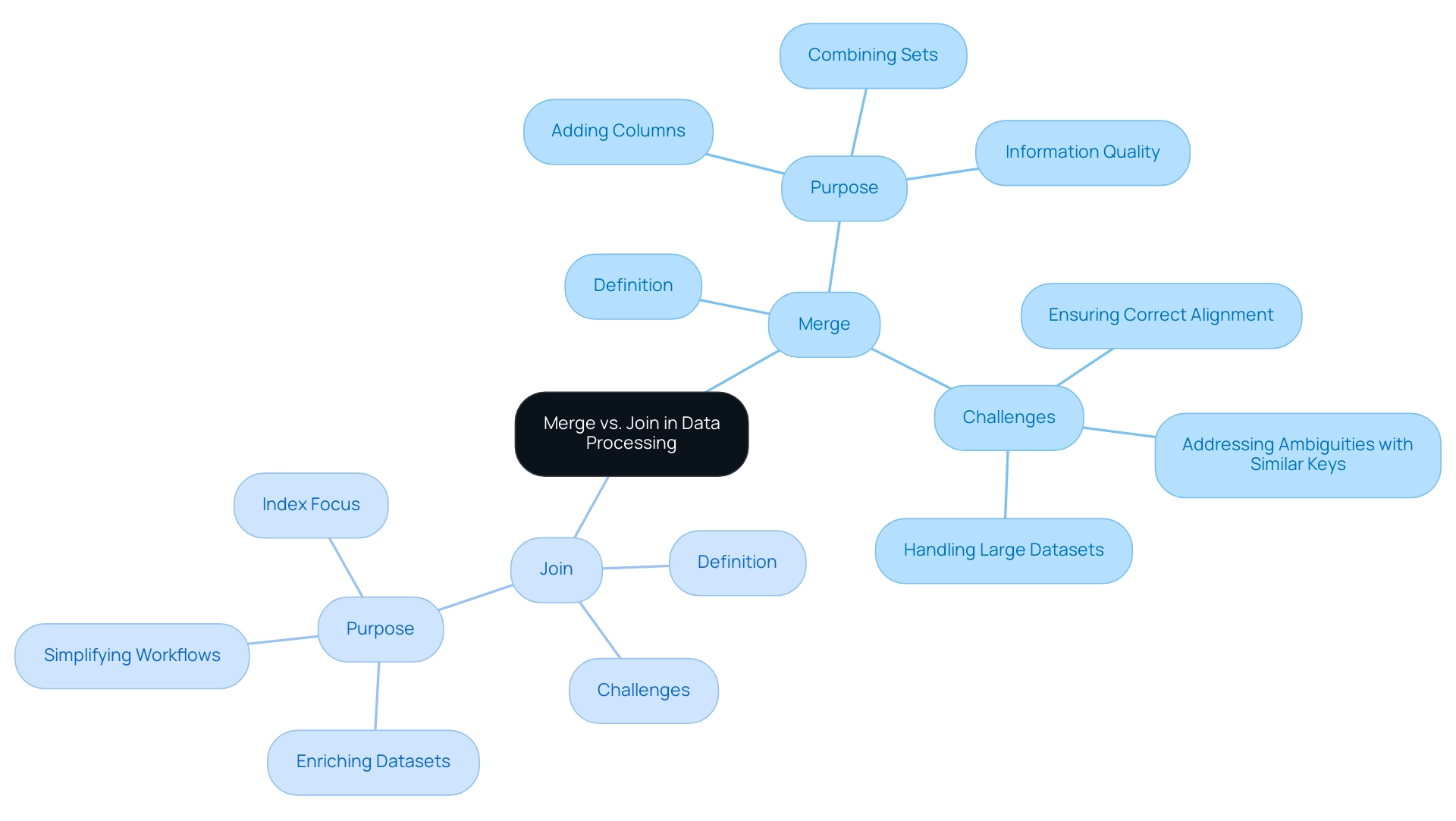
When to Use Merge: Practical Applications and Scenarios
Merging datasets proves particularly advantageous in scenarios where common columns exist, effectively illustrating the distinction between merge and join when other aspects may vary. For instance, when consolidating sales information from various regions that share the same product IDs, combining these datasets provides a comprehensive perspective of total sales across those areas. This method not only enhances visibility into regional performance but also aids in recognizing trends and opportunities for growth.
Understanding the difference between merge and join becomes crucial when consolidating information from various sources into a single dataset for thorough analysis. A practical example is the integration of customer information from different databases to create a unified customer profile, significantly improving targeted marketing efforts and customer relationship management. In the healthcare sector, the National Center for Health Statistics aims to connect hospital discharge records with other information sources to assess health outcomes, showcasing the practical application of dataset merging.
In the realm of operational efficiency, employing Robotic Process Automation (RPA) can further enhance these processes by automating manual workflows, thereby reducing errors and freeing up valuable resources for more strategic tasks. Statistics indicate that organizations utilizing efficient information integration methods, alongside RPA, can greatly enhance their decision-making processes. According to Mariam Anwar, Marketing Content Lead at Starmind, 50% of employees report that spending long hours searching for information hampers productivity and overall performance.
A case study on business intelligence empowerment revealed that companies capable of transforming raw information into actionable insights through integration experienced notable improvements in information quality and overall performance. This underscores the essential role of information integration in preparation for reporting and analytics, ultimately fostering growth and innovation. Moreover, tools like Astera Pipeline Builder facilitate the merging of information from various sources, ensuring flexibility in integration projects.
The transformative impact of Creatum’s Power BI Sprint has also been highlighted by clients, demonstrating how it accelerates analysis and reporting success, further enhancing operational efficiency.
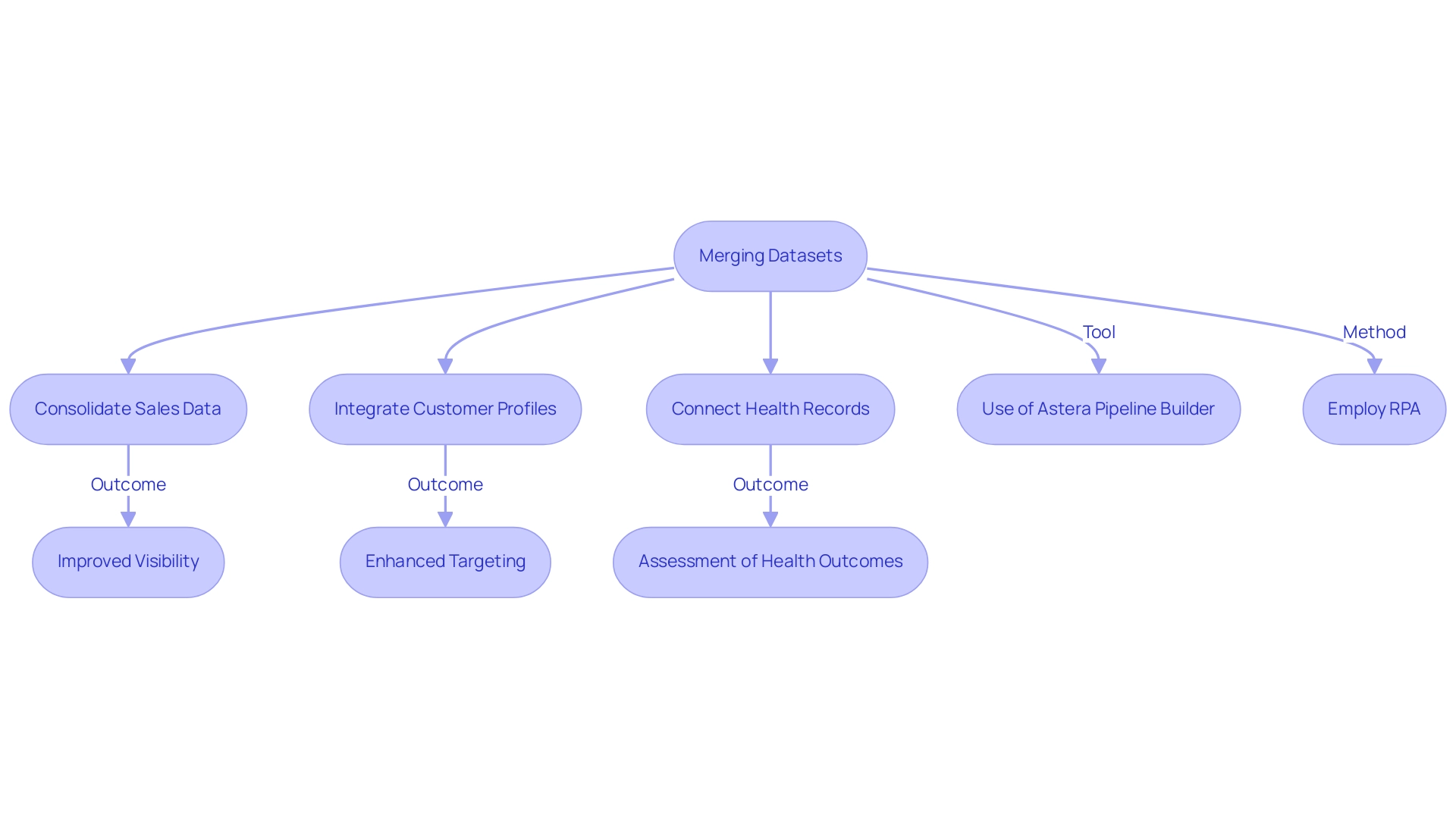
When to Use Join: Best Practices and Use Cases
Understanding the distinction between merge and join is crucial when combining data collections based on indices rather than columns. For instance, consider a scenario where one dataset contains user IDs, and another holds user activity logs indexed by those IDs. Using a combination operation in this context allows for the effective integration of activity information into user profiles, thereby enhancing the overall utility of the information and supporting informed decision-making.
To optimize performance when utilizing combinations, it is essential to ensure that indices are correctly established and that the datasets are appropriately indexed. This practice not only improves query performance but also enhances cardinality estimates, leading to more efficient data processing. Following query design guidelines can significantly aid in achieving these improvements, ensuring that connections are executed optimally.
In relational databases, where relationships between tables are defined by keys, recognizing the difference between merge and join can greatly streamline operations. This is particularly relevant in a rapidly evolving AI landscape, where efficiency is paramount.
Real-world applications of join operations are evident in various case studies. During the TEAM-UP clinical trial, for example, researchers faced challenges in managing diverse information sources, including wearable sensor data and electronic health records. By developing a relational database and a customized dashboard, they enhanced accessibility and usability, facilitating broader analysis and compliance with NIH sharing guidelines.
The dashboard enabled end-users to perform Excel-based queries and export datasets for analysis, thereby enhancing the research value of the collected information. This approach illustrates how efficient merging operations can ensure ongoing access to high-quality information, ultimately increasing its worth for both current research and future inquiries. Notably, 11 out of 34 residents in the trial were obese, underscoring the importance of robust information management in health-related studies.
Furthermore, performance metrics for combination operations indicate that well-structured merges can lead to substantial improvements in information processing efficiency. As noted by Jenny Alderden, an Associate Professor, “The benefits of using research data to the fullest potential far outweigh concerns about the cost because the data are now organized in a platform that can be accessed and explored by an increasing number of end-users for in-depth and secondary analysis, thus maximizing the value of the data for the current study and future exploration.” Industry experts advocate for the use of joins in user activity logs to grasp the difference between merge and join, as they enable detailed analysis of user behavior and engagement patterns.
By leveraging indices for joining data collections, organizations can unlock deeper insights and drive informed decision-making, ultimately enhancing operational efficiency through the integration of RPA and BI solutions.
Additionally, RPA specifically addresses the challenges posed by manual, repetitive tasks, allowing organizations to streamline their workflows and focus on more strategic initiatives. Tailored AI solutions can further assist businesses in navigating the rapidly evolving technology landscape, ensuring they identify the right tools to meet their unique needs. Without these advancements, companies risk falling behind competitors who effectively extract meaningful insights from their information.
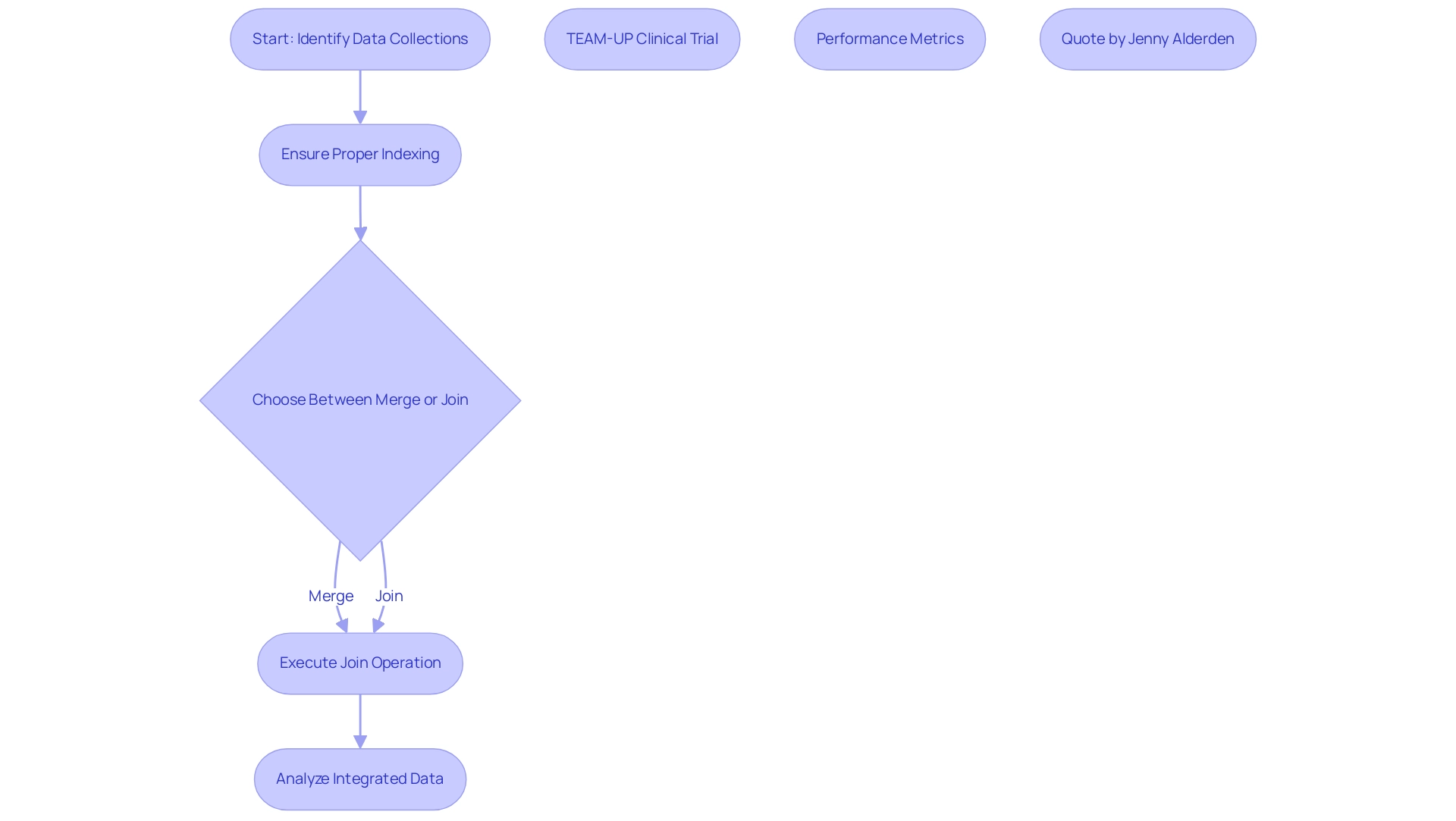
Performance Comparison: Merge vs. Join in Data Processing
In the realm of data processing, performance dynamics reveal significant differences between merge and join when handling large volumes of information. Merging is more resource-intensive, demanding greater memory and processing power to generate a new dataset. In contrast, joining modifies existing datasets in-place and often leads to faster execution times, particularly when dealing with millions of records.
For instance, a combination operation may complete more swiftly due to its reduced overhead, making it a preferable choice in scenarios where speed is critical.
However, the decision to consider the differences between merge and join should not solely hinge on performance metrics. It is essential to evaluate the specific information structures involved and the intended outcomes of the operation. Understanding these differences is crucial, as merging provides greater flexibility, enabling more complex information manipulations that may be necessary depending on analytical goals.
This flexibility can be vital for organizations aiming to drive growth and innovation through effective information strategies.
Incorporating Robotic Process Automation (RPA) from Creatum GmbH into these workflows can further enhance operational efficiency. By automating manual tasks related to processing information, RPA enables teams to concentrate on strategic analysis instead of repetitive handling. This shift boosts productivity and reduces the likelihood of errors, ultimately leading to more reliable data-driven insights.
Recent insights into resource consumption highlight that utilizing categorical information types can significantly reduce memory usage and enhance efficiency by understanding the differences between merge and join operations. This is particularly relevant when working with large datasets, as these differences can impact overall resource efficiency. As noted by CyCoderX, a specialist in information management, ‘Thank you for taking the time to read my article,’ emphasizing the significance of sharing knowledge within the processing community.
A case study titled ‘Performance Comparison Insights’ underscores the importance of exploring various options and techniques for efficient information joining. It emphasizes that performance outcomes can vary based on multiple factors, encouraging practitioners to conduct their own comparisons and share findings within the community. The study demonstrates that although integration can be resource-intensive, it may also offer essential capabilities for complex analyses, thereby promoting a collaborative approach that fosters deeper understanding and drives innovation in processing strategies.
By leveraging RPA, organizations can not only streamline their workflows but also enhance their ability to derive actionable insights, ultimately contributing to business growth.

Technical Differences: Syntax and Implementation of Merge and Join
In Python, particularly within the Pandas library, understanding the syntax for combining and joining data collections is essential for effective data manipulation. The merge() function is designed to facilitate combinations based on specified columns, offering greater flexibility in integrating data sets. For instance, merging two DataFrames on a common key can be accomplished with the syntax: pd.merge(df1, df2, on='key').
This method proves especially advantageous when handling collections that share common attributes yet differ in structure. When utilizing merge(), overlapping column names can be addressed by adding suffixes, thereby enhancing clarity in the resulting dataset.
Conversely, the join() function primarily serves to join DataFrames based on their indices, employing a simpler syntax, typically df1.join(df2). While both functions aim to combine information, grasping when to use each is critical to avoid common programming pitfalls, such as mismatched keys or unintended data loss.
To illustrate these concepts, consider a case study involving the integration of tree detail collections from various neighborhoods in Vancouver. By leveraging the merge() function, users can effectively amalgamate attributes from different tables, culminating in a comprehensive dataset that elevates information quality and enables deeper analysis. For example, if a New Arrivals table includes items like a microwave (10), dryer (30), and oven (20), merging this with other relevant collections can yield valuable insights.
Furthermore, to optimize the merge() function’s efficiency, it is advisable to ensure that the columns being merged are indexed or categorized. Specifying the join type with the how parameter can further streamline the process, rendering it faster and more effective than using join(), particularly with large data collections. This comprehension of the distinctions between merge and join, alongside syntax differences and best practices, is vital for developers striving to execute their manipulation tasks accurately and efficiently.
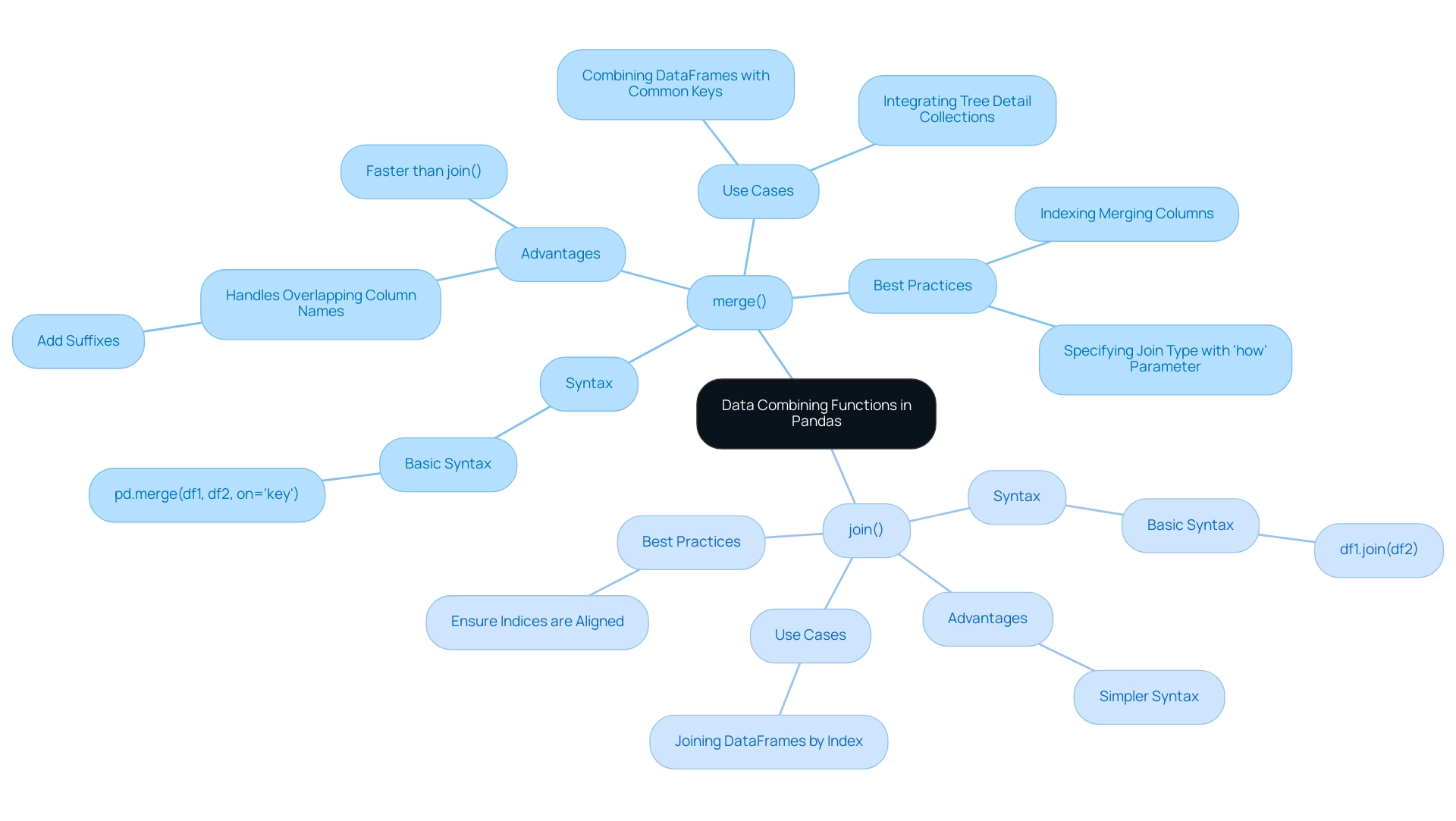
Common Pitfalls: Challenges in Merging and Joining Data
Understanding the difference between merge and join when working with datasets is crucial for avoiding common pitfalls that can significantly impact accuracy and processing outcomes. Mismatched keys represent one of the most critical issues, potentially leading to unexpected results or even information loss. For instance, if the key columns used for merging contain null values or duplicates, the resulting dataset may not accurately reflect the intended relationships.
Statistics reveal that a substantial percentage of analysts face challenges related to these mismatched keys, underscoring the necessity for vigilance in this area. As Luís Guilherme Astun Guedine aptly states, “Esse é um passo importante,” emphasizing the importance of grasping these challenges.
Moreover, neglecting to appropriately index collections before executing joins can lead to performance declines, rendering the processing workflow ineffective. The types of information involved also play a vital role; combining on a string key while one dataset includes integers can result in errors that compromise information integrity. Statistics from various frame surveys suggest that proper sampling can enhance coverage and reduce costs, particularly relevant in addressing issues tied to mismatched keys.
In terms of operational efficiency, leveraging Robotic Process Automation (RPA) solutions from Creatum GmbH, such as EMMA RPA and Power Automate, can significantly streamline manual workflows, minimizing errors and allowing your team to focus on more strategic tasks. Real-world examples vividly illustrate these pitfalls. A case study involving cloud-based storage for merged information revealed challenges in selecting the optimal hosting solution for consolidated datasets.
The outcome underscored the necessity of ensuring that all key columns were aligned and properly formatted to prevent complications during the merging process. This case highlights the critical nature of aligning key columns to enhance information quality and streamline workflows, essential for understanding the difference between merge and join in driving growth and innovation.
Expert insights stress that awareness of these challenges is vital for practitioners aiming to implement robust information processing workflows. The choice of merge model significantly impacts accuracy in machine learning applications, reinforcing the need for careful consideration in merging techniques. By addressing these common pitfalls and integrating RPA solutions from Creatum GmbH, analysts can improve the accuracy and reliability of their information sets, leading to more informed decision-making.
In a broader context, the organization’s unique value lies in providing customized solutions that enhance information quality and simplify AI implementation, driving growth and innovation.
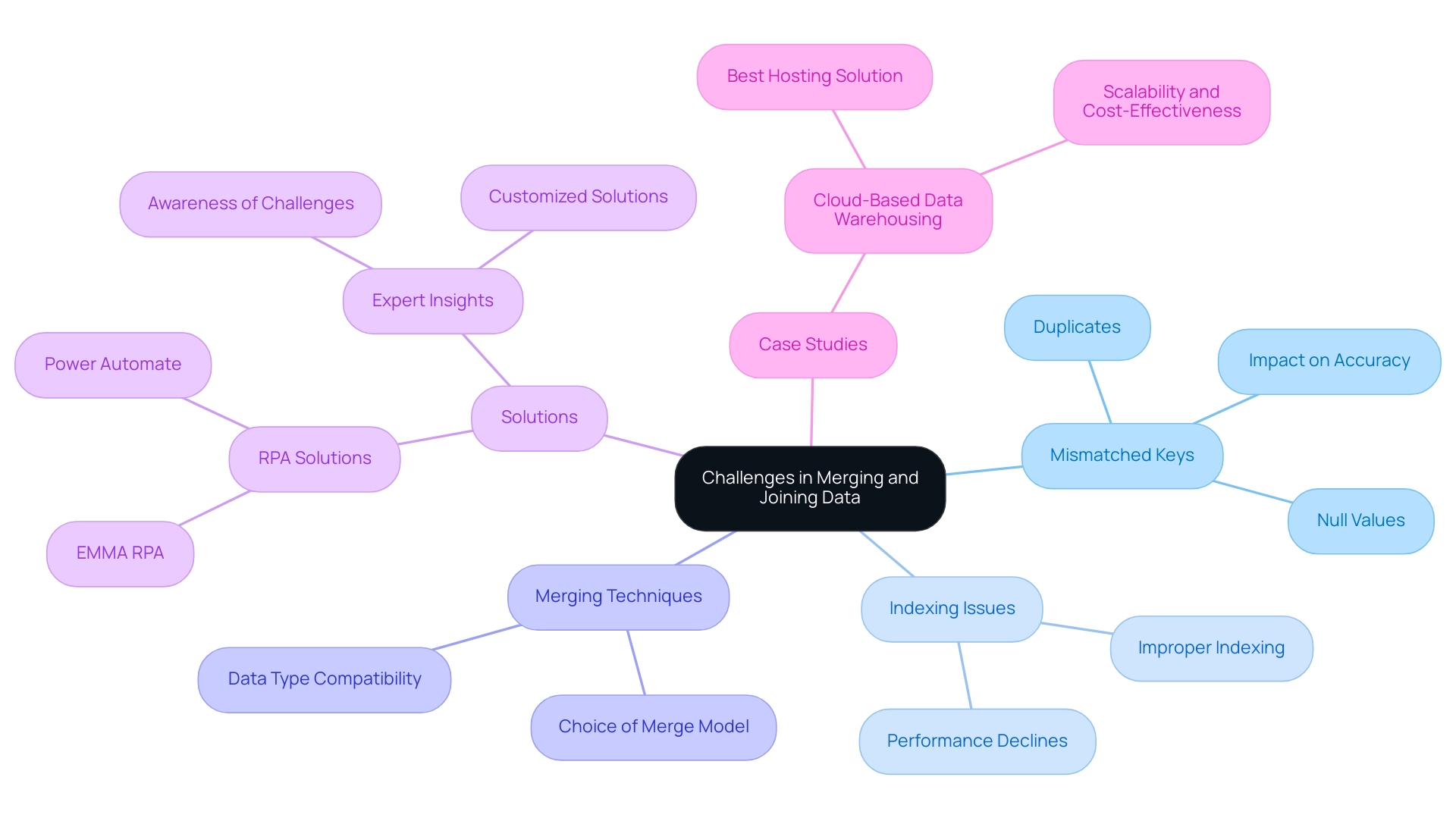
Key Takeaways: Summary of Merge and Join Differences
Merging and joining are fundamental operations in information processing. Understanding the difference between merge and join is essential, as each serves distinct purposes and yields different outcomes. Merging primarily unites collections based on common columns, making it particularly efficient for integrating related information from diverse sources. For instance, consider the baby name ‘THOMAS,’ which had a count of 4075. This statistic illustrates how combining can compile information based on shared characteristics.
In contrast, joining emphasizes operations that depend on indices, allowing for more adaptable information alignment. Recognizing the distinction between merge and join is crucial for evaluating the performance implications of each method. For example, combining can be computationally intensive, especially with large datasets, while joining may offer faster execution times under certain conditions.
The difference between merge and join also significantly influences syntax; combining typically requires specifying the columns to match, whereas joining often involves index-based operations.
Incorporating Robotic Process Automation (RPA) from Creatum GmbH into these information operations can greatly enhance efficiency. By automating the combining and joining processes, organizations can reduce manual effort, minimize errors, and free up valuable resources for more strategic tasks. RPA tools streamline workflows, ensuring that information is processed quickly and accurately, which is essential in today’s rapidly evolving AI landscape.
The challenges posed by manual, repetitive tasks can be effectively addressed through RPA, boosting efficiency and reducing errors. Pandas provides built-in methods to aggregate DataFrame columns, including .mean(), .median(), .std(), .max(), .min(), .nunique(), .count(), and .sum(). These techniques can be especially beneficial during combining and joining activities, enabling effective information handling and analysis.
Practical applications demonstrate the significance of the difference between merge and join. For example, a case study analyzing expenditure information from 2017 and 2018 utilized the group_by() function to compute summary statistics, revealing significant differences in mean spending and variability. Such insights can directly inform budgeting and financial planning decisions, showcasing the importance of Business Intelligence in driving data-driven insights and operational efficiency for business growth.
Key takeaways include:
- Understanding the difference between merge and join is crucial, as merging is optimal for combining datasets with common attributes, enhancing data quality and coherence, while joining is advantageous for aligning datasets based on their indices, facilitating efficient data retrieval.
- Performance considerations and syntax familiarity are essential for effective data manipulation.
- Leveraging RPA from Creatum GmbH can automate these processes, driving growth and innovation in data processing.
By grasping the nuances between merging and joining, and integrating RPA into these workflows, data professionals can enhance their analytical capabilities, driving growth and innovation in their organizations.
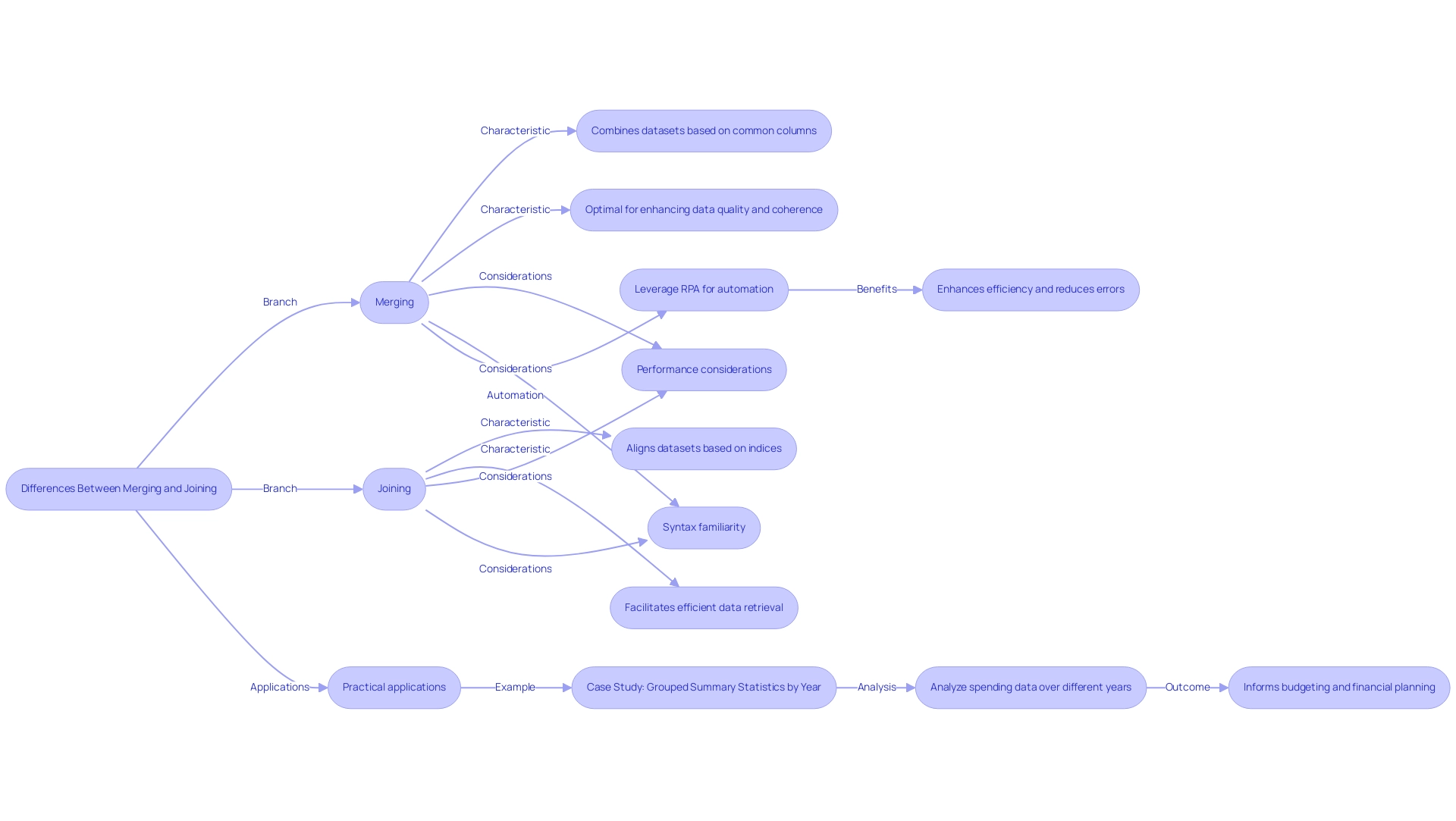
Conclusion
Merging and joining datasets are critical operations in data processing, each serving unique functions that significantly impact the quality and utility of data analysis. Merging is best suited for combining datasets based on shared columns, allowing for a comprehensive view of related information. This method enhances data visibility, aids in trend identification, and supports operational efficiency, particularly when integrating data from various sources.
In contrast, joining focuses on aligning datasets based on their indices, offering a streamlined approach to enrich existing datasets without altering their structures. This technique is especially useful for efficient data retrieval and can lead to faster execution times when managing large volumes of data. Understanding the key differences between these operations is essential for analysts, as it directly influences their ability to draw meaningful insights and make informed decisions.
Moreover, integrating Robotic Process Automation (RPA) into these processes can further enhance efficiency and reduce errors, allowing organizations to allocate resources to more strategic tasks. By automating the merging and joining workflows, organizations can ensure that data is processed accurately and swiftly, which is crucial in today’s fast-paced data landscape.
Ultimately, mastering the nuances of merge and join operations empowers data professionals to navigate the complexities of data analysis effectively. By leveraging these techniques, along with RPA, organizations can unlock the full potential of their data, driving growth and innovation in their respective fields.
Frequently Asked Questions
What is the difference between merge and join in information processing?
Merge involves combining two or more sets based on shared columns or indices, resulting in a new collection with additional columns. Join, on the other hand, focuses on combining datasets based on their indices, adding columns from one dataset to another without altering the original datasets.
When should I use merge instead of join?
Merge is typically used to consolidate information from various datasets, especially when there are common columns. It is beneficial for creating a comprehensive view of data, such as consolidating sales information from different regions sharing the same product IDs.
What are some practical applications of merging datasets?
Merging datasets can create unified customer profiles from different databases, enhancing targeted marketing efforts. In healthcare, merging hospital discharge records with other information helps assess health outcomes.
How can Robotic Process Automation (RPA) enhance merge and join operations?
RPA can automate manual workflows involved in merging and joining datasets, reducing errors and freeing up resources for more strategic tasks, thereby improving operational efficiency.
What challenges might arise when using merge and join operations?
Challenges include managing extensive collections of data, ensuring proper alignment of combined records, and addressing ambiguities with similar keys, which can complicate the merging and joining processes.
How does understanding merge and join operations impact analytics?
Mastering these operations enhances the quality of information and facilitates the extraction of meaningful insights, driving informed decision-making and strategic growth.
Can you provide an example of a case study related to merge and join operations?
The case study titled ‘The Yin and Yang of Data Joins: Slice and Dice Data Like a Samurai’ illustrates filtering combinations using the dplyr package, showcasing how semi-joins and anti-joins can refine datasets based on their relationships.
What tools can assist with merging datasets?
Tools like Astera Pipeline Builder facilitate the merging of information from various sources, ensuring flexibility in integration projects and enhancing the overall quality of data.
What benefits do organizations experience from effective information integration?
Organizations that effectively integrate information can improve decision-making processes, enhance information quality, and foster growth and innovation, as evidenced by case studies on business intelligence empowerment.

